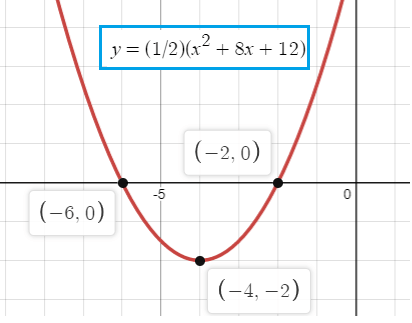DETERMINE A QUADRATIC EQUATION GIVEN THE ROOTS AND A POINT
The quadratic function will be in the form
y = ax2 + bx + c
this will have two roots α and β.
Roots = zeroes = x-intercepts
To find quadratic function from the given roots, we follow the steps give below.
Step 1 :
The given roots can be converted into factored form
x = α ==> (x - α)
x = β ==> (x - β)
y = a(x - α)(x - β)
Step 2 :
To figure out the value of a, we apply the given point.
Problem 1 :
The roots of a quadratic equation are -2 and -6. The minimum point of the graph of its related function is at (-4, -2). Sketch the graph of the function.
Solution :
α = -2 and β = -6
α + β = -2 - 6 ==> -8
α β = -2 (-6) ==> 12
The quadratic function will be,
y = a(x2 - (-8)x + 12)
y = a(x2 + 8x + 12)
Since the quadratic function is having a minimum point (-4, -2), the will pass through this point.
-2 = a((-4)2 + 8(-4) + 12)
-2 = a(16 - 32 + 12)
-2 = a(-4)
a = 1/2
By applying the value of a, we get
y = (1/2)(x2 + 8x + 12)
So, the required quadratic function is
y = (1/2)(x2 + 8x + 12)

Problem 2 :
The roots of a quadratic equation are -6 and 0. The minimum point of the graph of its related function is at (-3, 4). Sketch the graph of the function.
Solution :
α = -6 and β = 0
α + β = -6 + 0 ==> -6
α β = -6 (0) ==> 0
The quadratic function will be,
y = a(x2 - (-6)x + 0)
y = a(x2 + 6x)
Since the quadratic function is having a minimum point (-3, 4), the will pass through this point.
4 = a((-3)2 + 6(-3))
4 = a(9 - 18)
4 = a(-9)
a = -4/9
By applying the value of a, we get
y = (-4/9)(x2 + 6x)
So, the required quadratic function is
y = (-4/9)(x2 + 6x)

Recent Articles
-
Finding Range of Values Inequality Problems
May 21, 24 08:51 PM
Finding Range of Values Inequality Problems -
Solving Two Step Inequality Word Problems
May 21, 24 08:51 AM
Solving Two Step Inequality Word Problems -
Exponential Function Context and Data Modeling
May 20, 24 10:45 PM
Exponential Function Context and Data Modeling